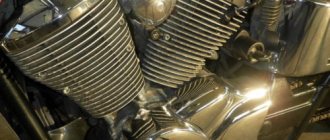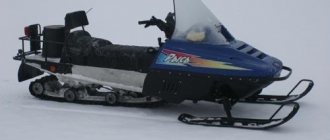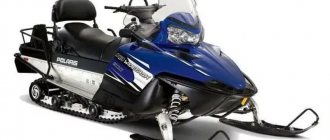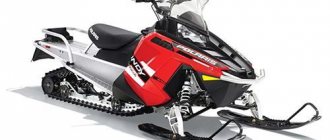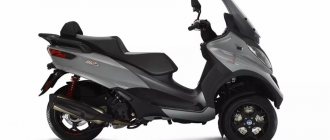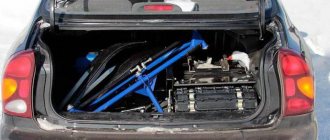The Yamaha Nitro snowmobile (Snowbike Yamaha FX Nytro) is a series of Japanese snowbikes with four-stroke three-cylinder engines with a displacement of 1049 cm3 and a net power of up to 175 horsepower (according to the manufacturer). The first snowmobile of this model rolled off the assembly line in 2007, and then modernized versions of the snowmobile were regularly produced, both with minor changes in appearance and with tuning of entire components of the snowmobile.
Yamaha's 2014 Nytro MTX comes in 153cm and 162cm tracks. The wide lip of the Snow Moto MT-9 provides good stability and controllability of the snowmobile, which is especially necessary when traveling in deep snow. According to owner reviews, the Nitro 162 model with a Camoplast Ascent track is more suitable for long mountain climbs, and the 153 model with a Camoplast Maverick transmission is less powerful, but benefits from its lighter weight.
000_moto_1111_038
Yes, indeed, there is much more virgin snow in our country than well-groomed paths, where sports (read: fashionable in our country) models are at ease, and the one who thinks that in a machine for deep snow you will not get either an adrenaline drive or a thrill from "Grips". The mind-buster - FX Nytro M-TX. And it’s not just about wide skis and an unrealistically long track with huge “oars” - grousers: the machine’s trump card is its original concept, which implies absolute maneuverability in snow of any depth.
The engine is quite atypical for “three tuning forks”: not an in-line “four” from the R1, not a pair of two engines from the WR250, not an “air” two-stroke, but an in-line four-stroke “three”! This is not an alien from the world of motorcycles, but a separate development specifically for snowmobiles, and another confirmation of this is the cubic capacity of 1050 cm³, which is atypical for motorcycles. However, experts will immediately appreciate this solution: the torque and traction at the bottom of the “troika” is higher than that of a four-cylinder sportbike engine, and at the top it is not so sharp and unrestrained - just what is needed to turn a long caterpillar even on a heavy wet snow!
But this is a theory. In practice, in front of me is a very unusual-looking car, somewhat reminiscent of a long-tailed parrot: a downed body, a lean silhouette and a long, very long tail, only instead of feathers there is aluminum covering a huge track. Such a large “goose” is needed in order to create a solid contact patch and minimal pressure on loose snow, and three-inch (in our opinion 7.5 cm) snow claws are needed to avoid digging. At first, with a great deal of skepticism, I speculated about the car’s handling, however, after taking a closer look at the track, I realized that it was too early for me to be upset. The fact is that the slides are not straight, but with a beveled rear part: it turns out that on crust and compacted snow only the central part of the track touches the surface, and as soon as it sags slightly into the “powder”, the weight is distributed over the entire area of the track.
On the move, the car turned out to be quite easy to operate, as far as this term is generally applicable to such “tractors”. The kinematics of the steering is such that wide skis can be easily “shifted” from one extreme position to another while standing still. Of course, the electric power steering used on the Apex X-TX model is very welcome here, but even without it the car does not seem difficult to drive. Apparently, this is due to its low weight: a three-cylinder engine, an aluminum frame and “nothing superfluous” give this seemingly clumsy and bulky car, if not ease of steering, then certainly adequate obedience.
The engine deserves a separate paragraph, its character is exactly what an all-climb snowmobile should have: smooth, torquey and confident, and at the same time very fast. There is no hint of insufficient torque, no delay when sharply pressing the gas: the injection “three ruble” “follows” the lever under the thumb as if glued, and it is helped in this by a well-tuned variator, which, unlike the transmissions of sports cars, does not overclock the engine in vain, but completely and clearly transmits considerable torque from each 350 cc cylinder to the track. Compared to two-stroke “mountain” competitors, the M-TX is able (and well!) to start under pressure without jerking, which in deep, loose snow gives less chance of the track to dig in at the start.
I didn’t like the unclear operation of the transmission mode selector: when moving from the “forward” to the “backward” position, the reverse sometimes did not turn on the first time. Moreover, as soon as the car, after a series of good annealings in the virgin soil, stood for five or six hours in the cold, the reverse handle completely stuck up (while driving, the snow dust stuck to it melts from the heat of the engine, water flows into the cracks at the lever rod, and when the engine cools down, everything freezes safely). “But it’s not all bad that it’s warm,” the heated gas trigger and steering wheel grips say in unison. They are not just powerful, but very powerful, sometimes your hands get really hot, especially if you are riding in not very thick gloves. However, the degree of their heat transfer is easy to set and track: the display shows data about the enabled mode for the trigger and handles separately.
And now, through the pros and cons, we come to the sleeve in which the FX Nytro hid its main trump card: it allows you to go where you want, and not where you can. Let me explain: those snow drifts near Moscow that we are used to storming at the annual presentation tests of new equipment are not like a kindergarten, but a full nursery compared to the suburbs of Novosibirsk, in which I first had the opportunity to test this snow-all-terrain vehicle. How do you like this? — I rode smoothly and effortlessly through the virgin snow and stopped on a seemingly flat wasteland to take a couple of photos, and after dismounting, I fell into the snow up to my chest (with a height of 183 cm). The important thing is that the Yamaha doesn’t just drive or make its way through the “powder”, burying itself in the headlights, but that it calmly rushes along this very virgin snow at a speed of “well over a hundred”, and confidently and unshakably. And who will now say that you can only “have fun” in light sports cars on well-groomed paths? Wake up, on Nitra you can do this absolutely anywhere - on any snow. You can not only race, but also, with certain skills, “twist donuts” on your side, emerge from under the snow dust and jump on hummocks. Thanks to the breaking torque of the engine and the excellent adhesion of the track to the snow, the car does not slip during a sharp start, but literally stands on the track. Of course, there is no talk of riding “in a candle”, like on a motorcycle, but the car covers the first couple of tens of meters, cutting through the air with skis, the main thing is not to turn off the gas! And only at a speed of “over 140” does the acceleration rate weaken. There is so much traction that in terms of acceleration dynamics the car is not much inferior to the flagship Apex, and this lump of kinetic energy is easily curbed by a disc brake with a four-piston caliper, which forces the caterpillar to bite into either loose snow or crust and slow down the snowball like an anchor.
A separate topic is jumping. The seemingly heavy car actually turned out to be very “flyable”, especially after adjusting the pneumatic shock absorbers (the pump for them, by the way, is included in the transportable spare parts), after each jump I gained more and more confidence in myself and the car. And the point here is not only in its excellent weight distribution, but also in the presence of metal arches above the foot platforms, which prevent the driver’s boots from jumping out of the “foot” space not only during flight, but also when landing. In addition, due to the fact that the long caterpillar has a strong moment of inertia, when lifting off from a springboard, it is very easy to set the trim of the car with gas.
The machine performs well not only on powder: you also feel quite confident on groomed paths; the skis, despite the “virgin” orientation, go very well on hard white surfaces, without giving up in turns. The secret is that the “ridge” of the skis (that is, their central part) does not have a smooth surface, but is striped with small longitudinal grooves that bite into the creaky, dense snow.
Repair and tuning
Yamaha Nitro is a true conqueror of the mountain slopes. The Japanese company worked on the design of the car and installed the most modern “filling”. Fans of driving in the snow will be 100% satisfied with the car, but professionals will want to install a track with high teeth. Otherwise, the snowmobiles of the series do not require modification.
The developer also provided for the repair of the device. The design allows you to fix almost any problem yourself. Unfortunately, the cost of original spare parts is steep. But the reliability of the snowmobile smooths out the rough edges.
007_moto_1111_038
RESULT. The Yamaha FX Nytro is a truly versatile sled: it can do it all. It can rush across the white plains, raising sparks of snow dust into the air, it can storm deep and loose drifts, it can become both a weekend car - “for fun”, and a workhorse for harsh operating conditions. The main thing is to park it in front of the exit at night.
Photo
Yamaha Phazer r-tx
Yamaha Nytro xtx
Yamaha Nytro rtx se
Yamaha Nitro with case
Yamaha Nitro snow scooter for children
Yamaha Nytro mtx 153
008_moto_1111_038
Pavel Kurlapov, editor of "Moto"
Pavel Kurlapov, editor of "Moto"
I admit, I have an irrational weakness for all types of off-road vehicles, be it an ordinary UAZ loaf, a Kirovets tractor or a snowmobile. It is much more important for me to know that, if anything happens, I can climb over a curb, drive into a forest, or get directly to my destination, rather than having to walk to it from the road, than to have the ephemeral opportunity to “pull” or enjoy super-calibrated handling. Although, of course, if a device combines these qualities, it has no price at all.
“One hundred and sixty-second nitra” turned out to be from this breed. I, of course, had heard a lot about how “mountain” snowmobiles are much better “rogues” than sports ones, and at the same time are just as different from them in terms of controllability and speed, but I never expected the combination of absolute all-climbability and more than decent dynamics . I had the opportunity to get acquainted with Nytro in the Moscow region, at the Ivankovo Reservoir, where the surface of a frozen reservoir with a hard and even snow cover gives way to waist-deep snow-covered islands. The first kilometers on ice as flat as a table showed that the Nitra picks up speed effortlessly at 140, it seems that the torque would be enough for another similar device. And due to the long caterpillar and widely spread skis, even at speeds of “far over a hundred”, the snowball holds its course perfectly.
The “passable” capabilities of the device surprised me throughout the entire test, from the first to the last meter. Snezhik easily drives onto almost sheer steep banks two meters high, successfully makes a path through dense forest and dry reeds, and then with the same ease jumps over a ditch with unfrozen water. In this one I had to turn around, because I ran into the road, emerging from the dense forest. To be honest, starting pirouettes on the steep slope of the ditch, rinsing the caterpillar in the black icy water and trying not to break the plastic on the nearest tree, I was already seriously wondering where and how long I would have to walk to find someone to help me pull out a stuck (or even overturned) snowball from its snow-water-wooden captivity. To my surprise, the Nitra skidded its caterpillar just once and crawled back onto its own beaten path without much difficulty. The FX Nytro truly has all-terrain capability. There is no snow in the world in which he would refuse to ride. And even if the long “tail” behind the stern does not look “boyish”, what an impression is made by a 3.5-meter colossus that takes off and rushes into the distance, planing like a boat!
| TECHNICAL SPECIFICATIONS Yamaha FX Nytro M-TX162 (manufacturer data) | |
| COMMON DATA | |
| Model year | 2010 |
| Length x width x height | 3340 x 1210 x 1195 mm |
| Weight, kg | 274 |
| Seat height, mm | 760 |
| Gas tank volume, l | 28 |
| ENGINE | |
| Type | R3, 4T |
| timing belt | DOHC, 4 valves per cylinder |
| Working volume, cm³ | 1049 |
| Compression ratio | 10,5:1 |
| Max. power, hp at rpm | 130/8000 |
| Supply system | fuel injection, throttle Ø 41mm |
| Cooling system | Liquid |
| Starting system | electric starter |
| TRANSMISSION | |
| CVT with engine braking system, modes: “forward”, “backward” | |
| CHASSIS | |
| Frame | aluminum spatial |
| Front suspension | double wishbone, A-arm, ski travel 216 mm |
| Rear suspension | slick, track travel 381 mm |
| Brake system | disc Ø 220 mm on transmission, 4-piston caliper |
The test was organized by Yamaha motor CIS.
Powder conqueror: Yamaha FX Nytro M-TX162
Characteristics
Below is a comparative technical specification of the Yamaha Nytro snowmobile from different years of production.
Yamaha dealers also offer to improve their Nitro snowmobile by installing an MPI turbo turbine, which allows increasing the power of the power unit to 130 kW. To get the maximum effect from such tuning, the manufacturer recommends installing an original direct-flow muffler, a sports switch and a branded rear shock absorber. The appearance and useful capacity of a snowmobile can be improved by installing a special case and purchasing a sled.
By the way, in addition to the snowbike, the Yamaha concern produces a children's snowmobile of the same name, the Yamaha Snowbike FX Nytro. This mini snowmobile (codenamed Gimpel YM13802) looks like a mountain bike and is similar in appearance to its big brother, but the motor and wiring are missing.
Review of the Yamaha Nytro snowmobile and its modifications (with video and prices)
The Yamaha Nitro snowmobile (Snowbike Yamaha FX Nytro) is a series of Japanese snowbikes with four-stroke three-cylinder engines with a displacement of 1049 cm3 and a net power of up to 175 horsepower (according to the manufacturer). The first snowmobile of this model rolled off the assembly line in 2007, and then modernized versions of the snowmobile were regularly produced, both with minor changes in appearance and with tuning of entire components of the snowmobile.
Yamaha's 2014 Nytro MTX comes in 153cm and 162cm tracks. The wide lip of the Snow Moto MT-9 provides good stability and controllability of the snowmobile, which is especially necessary when traveling in deep snow. According to owner reviews, the Nitro 162 model with a Camoplast Ascent track is more suitable for long mountain climbs, and the 153 model with a Camoplast Maverick transmission is less powerful, but benefits from its lighter weight.
Video
Auto mechanic with over 20 years of experience in the repair and maintenance of automobiles and motorcycles. I write articles and answer questions from visitors to the skuterov website. ru
Of course, the cost is steep - you can buy a car. Are used Yamaha snowmobiles sold in Russia? I wonder how much it will cost.
So what is correct Nytro or Nitro?
It's a good snowmobile, but I have a problem: error 43 appears when starting. Has anyone encountered this situation? Help me solve it without repairs.
Fuel consumption
Fuel consumption, which is indicated in the official technical specifications of the Yamaha XT660X motorcycle, is 5.5 liters per 100 kilometers. However, several factors affect the accuracy of the indicators. Firstly, consumption depends on the condition of the parts, the degree of their wear, the tenacity of materials, and the like. But in any case, the power produced by the engine will be lost on average up to 20% on the way from the crankshaft to the drive wheel. Secondly, the tires installed on the motorcycle and the air pressure that is created inside the tires have a huge impact on fuel consumption. Each surface, be it asphalt or sand, must use its own parameters. Hard surfaces require higher tire pressure, while loose surfaces require lower tire pressure. The Yamaha XT660X, as mentioned earlier, is initially equipped with innovative Pirelli tires specially designed for city driving.
Thirdly, fuel consumption is affected by the streamlining of the motorcycle. The designers of the Yamaha XT660X motard took care of the ergonomics of the motorcycle, creating the necessary fairings and wind shields.
Fourthly, fuel consumption depends on driving style. That is, if you don’t “gas” too much, then less fuel will be wasted. In addition, the weight of the bike and the rider himself significantly affects consumption.
Review of the Yamaha Nytro snowmobile and its modifications (with video and prices)
The Yamaha Nitro snowmobile (Snowbike Yamaha FX Nytro) is a series of Japanese snowbikes with four-stroke three-cylinder engines with a displacement of 1049 cm 3 and a net power of up to 175 horsepower (according to the manufacturer). The first snowmobile of this model rolled off the assembly line in 2007, and then modernized versions of the snowmobile were regularly produced, both with minor changes in appearance and with tuning of entire components of the snowmobile.
Yamaha's 2014 Nytro MTX comes in 153cm and 162cm tracks. The wide lip of the Snow Moto MT-9 provides good stability and controllability of the snowmobile, which is especially necessary when traveling in deep snow. According to owner reviews, the Nitro 162 model with a Camoplast Ascent track is more suitable for long mountain climbs, and the 153 model with a Camoplast Maverick transmission is less powerful, but benefits from its lighter weight.
Yamaha XT660X: spare parts
As mentioned earlier, the Yamaha XT660X is a common and popular motorcycle. It was originally made for the European market, so there are no problems with spare parts, their availability and price. Any part or even unit can be purchased at a good price. Sellers offer either original spare parts, which are transported through Vladivostok, or Chinese ones. The original components, of course, are much more expensive.
Here everyone chooses for themselves - either quality or price. Used spare parts can be purchased on various online trading platforms and shops.
History of creation
The XT series of motorcycles was invented by the designers of the YAMAHA concern back in 1976. Initially, the engineers were tasked with developing a device that could not only quickly pick up speed, but also drive over sharply rough terrain without noticeable losses. That is, the task was to develop an enduro with a Central European cubic capacity of 600 cubic meters. cm.
The first batch of XTs were equipped with 500cc single-cylinder four-stroke engines. cm. This model was a real enduro: duplex frame, suspension, engine, high-mounted muffler. These motorcycles sold well all over the world and were very popular. In addition, the first XT models won the Paris-Dakar rally several times in a row in the late 70s. But already in the mid-80s, YAMAHA carried out a radical modernization of the motorcycle with a change in the basic operating principles. The volume of the power unit increases to 595 cc. cm. A four-valve cylinder head is installed on it. A disc brake appears on the front wheel. Users considered the only disadvantages of the motorcycle to be the insufficient rigidity of the frame and gearbox, which did not always work smoothly.
Further improvements to the original model lead Yamaha engineers to the birth of the Yamaha XT660X in 2004. This motard is equipped with a single-cylinder four-stroke engine of increased volume (660 cc). The device is designed specifically for the city with the ability to travel to unequipped and unpaved sections of the road. Thanks to the inherent design innovations, the car allows you to drive fast. It is quite dynamic and manageable within the city. You can maneuver it perfectly, change lanes, and take turns.
Price
A brand new bike from a showroom will cost about 1.8 rubles. Official dealers offer loans from 40 thousand rubles. per month. One of the early modifications can be purchased on the secondary market from 255 thousand rubles. Popular versions from 2007-2009 with a mileage of 10,000-15,000 km. you can get it for 300-400 thousand rubles.
A sportbike is not a cheap pleasure, but the high cost is not a reason to deny yourself. Those who want to ride the legendary motorcycle should pay attention to Japanese auctions. A large number of offers at affordable prices is not the biggest plus. The main advantage is that the exhibited models have no mileage in the Russian Federation and are sold in good condition. You can view prices at the Japanese auction for this model here.
Lightweight CF die-cast FX frame.
Integrating the chain guard into the chassis structure is one of the benefits of Yamaha's exclusive Controlled Flowdiecasting technology. By reducing the size of small air bubbles in the metal during the casting process, Yamaha engineers were able to cast thinner-walled and more complex, feature-rich components, allowing the chain housing to be cast directly into the snowmobile frame.
Comparison of Yamaha FX Nytro with competitors and analogues
Yamaha produces reliable and relatively inexpensive equipment. But despite this, Japanese snowmobiles have more than enough competitors. The main opponents are BRP, Arctic Cat and Polaris.
The competition for the Yamaha snowmobile was: Polaris Switchback Pro R 800, Arctic Cat XF 800 and Ski-Doo Renegade E-TEC 800. All machines are in the same price category and practically do not differ in technical characteristics. The only difference is power. The working volume of the Japanese is 1049 cubic meters. cm, and the same Canadian has only 799.5 cubic meters. cm.
There is competition within the company as well. The Yamaha Nitro snowmobile performs well not only in extreme conditions, but also on the track. The series is a worthy competitor to the Venture line of travel devices. At the same time, cars for driving in the mountains are much cheaper than tourists. The price of Ventura models ranges from 1.1 to 1.3 million rubles, and Nitro costs from 420 to 800 thousand rubles.
Appearance
| Frame material | Aluminum |
| Housing panel material | Plastic |
| Frame model | FX™ |
| FloorBoard Location | Driver |
| Slip resistance | + |
| Snowboard mount for tunnel | + |
| Handles | Standard |
| Saddlebag protection | — |
| Belt protection | + |
| Hand Guards | — |
| Shield protection | — |
| ExhaustGuard | + |
| LightGuard | — |
| Clutch protection | + |
| Snow protection | + |
| Side panel | + |
| Fuel Tank Cover | — |
| Shock Cover | — |
| Steering wheel | Standard |
| Front bumper | Standard |
| Rear bumper | Standard |
| Underbody protection | Standard |
| Steering wheel hooks | Standard |
| Ski material | Plastic |
| Ski handles | Standard |
| Skag material | Carbide |
| Mountain steering wheel | Standard |

